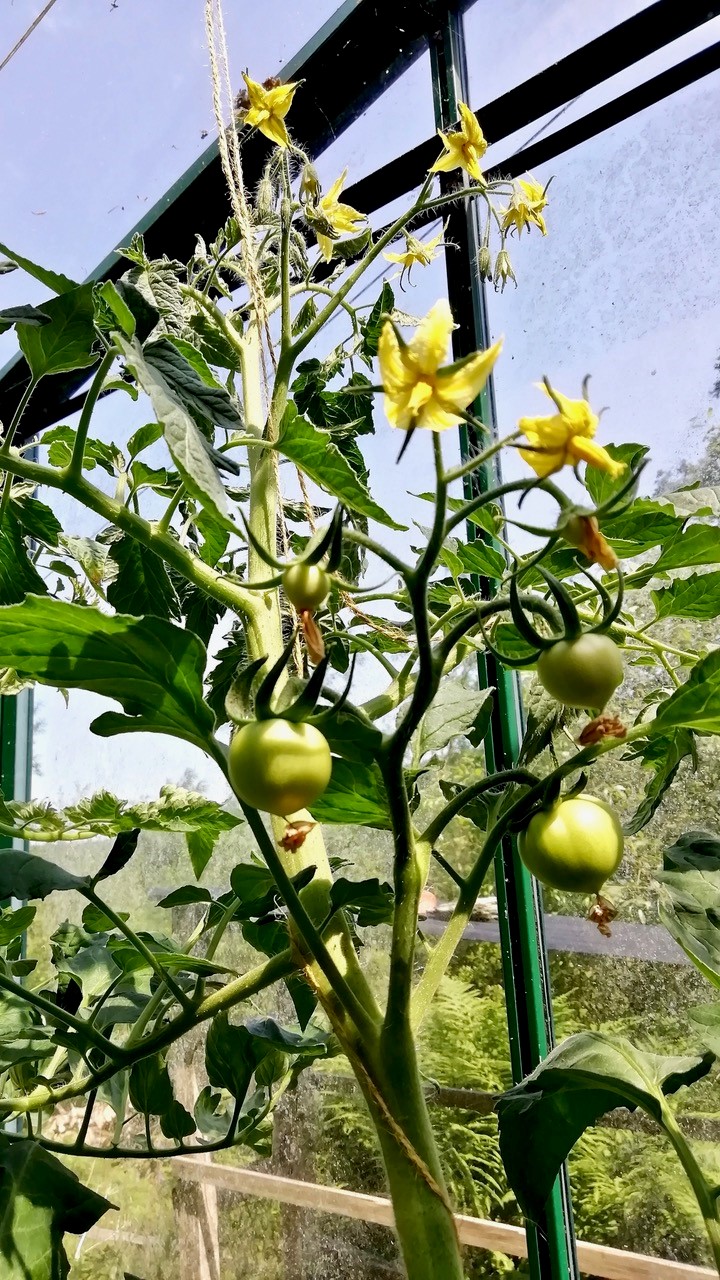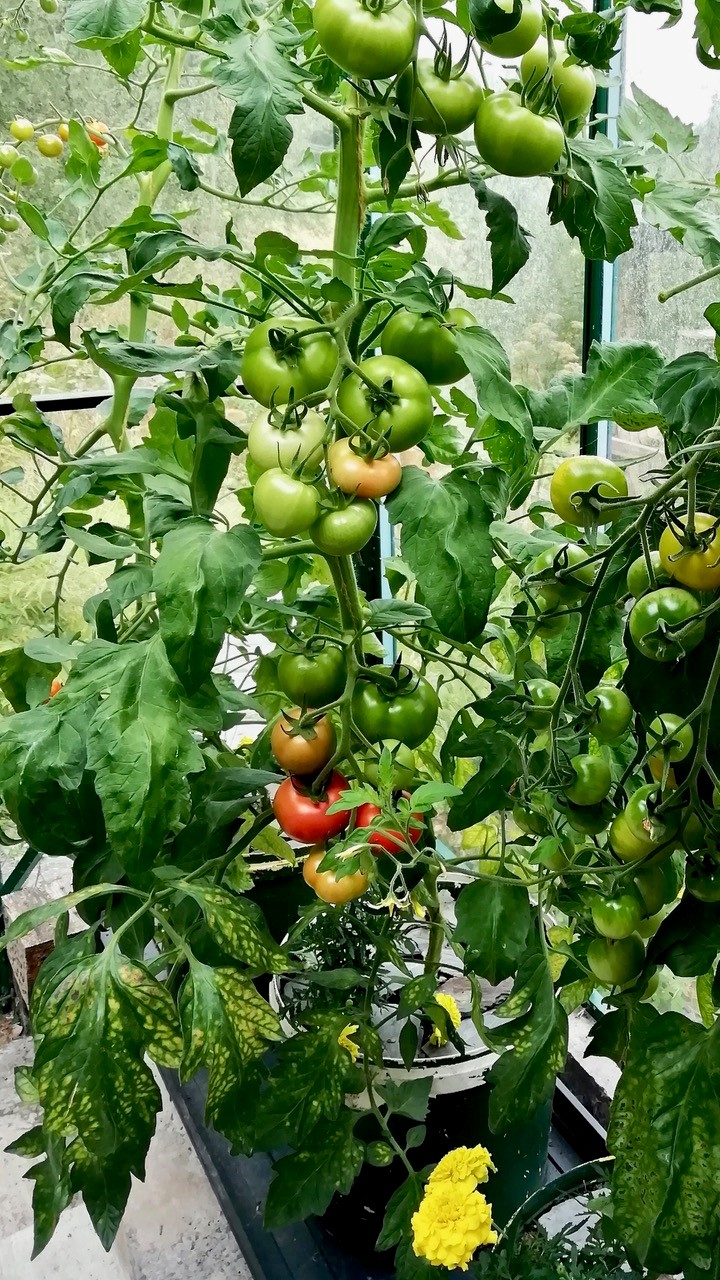Why would you want a blight-beating tomato in your greenhouse, where blight is rarely an issue? Because in these increasingly unpredictable times, it pays to think laterally.
Solutions to gardening problems sometimes arrive in moments of sheer serendipity. My greenhouse was the setting for such a moment last summer, when the conditions inside flipped from being as perfect as they get here for growing tomatoes – sunny with minimal rain and low, low humidity – to sun-starved with endless dankness and rocketing damp. Such are the perils of gardening among the fragments of the Celtic rainforest.
I dread this yearly watershed; it marks the turning point between non-stop abundance of healthy and flavoursome tomatoes, and their gradual decline into yellow-blotched, leaf-mould-ridden leaves and botrytis-spotted, insipid fruits.

This breakdown usually starts sometime in August, depending on what the weather’s doing. Humidity is the tomato-killer here: air so moist you can almost wring it out. Tomato leaf mould (Fulvia fulva) is my nemesis.
In a bad year, I’m salvaging what’s left of the toms by the end of August; in a good year, with some redeeming sun, an end to watering, and plenty of breeze, some trusses soldier on into September. The thud of a heavy, still-green beefsteak crashing to the greenhouse floor, its snapped stalk quietly riddled with hidden mould, reminds me just how fleeting the ‘rainforest season’ for tomatoes here can be. By October, the game’s up; any last, flavour-flagging trusses are brought indoors to ripen in a sunny window.
Late last summer, things were very different – thanks to a spring scramble. Having missed almost every last-order date for postal organic and peat-free plug plants, I grabbed what I could. Among some favourites – F1 ‘Sungold’ and F1 ‘Sweet Million’ are must-munchers here – were some other cordon varieties whose names I vaguely recognised, plus a few newbies.
More scrambling meant they were quickly potted up, grown on and then planted into their big greenhouse pots in early June. We had a half-decent summer here, so they grew like billy-o (in the previous summer’s peat-free compost, rejuvenated by the addition of digestate) into strong, healthy plants laden with flowers, and later fruits.

By Celtic rainforest standards, they excelled. We harvested fruits non-stop all summer. The trusses kept blooming, then fruiting, and we kept on picking, well on into August – and I gave thanks to the tomato gods for keeping spoiling moulds at bay. Then, after a run of cold, damp nights, the first yellowing specks and patches appeared – but not on all of the plants.
Some shone with the vitality they’d shown all summer, while poor ‘Sungold’ succumbed to its fungal foes. September arrived: ‘Sweet Million’ was looking sad, but the plants in neighbouring pots were still dark green, decked out with non-stop flowers and trusses of gleaming, tasty fruits. Watering had long ended by now (and I never dare wet the greenhouse floor to ‘damp down’).
October dawned: ‘Sungold’ was on its last legs, but some of the other plants were… still dark green, decked out with non-stop flowers and trusses of gleaming, tasty fruits. I double-checked to be sure which month it actually was. Lessening sunshine, more rain and full-on humidity or not, the gods were clearly on my side. Leaf mould? What leaf mould?
Those disease-defying tomatoes, with their unfamiliar names, showed no signs of slowing down, even in October; despite having their tops pinched out, they still tried to push the greenhouse roof off. It was only on checking their labels that the ‘how come I have healthy and mould-free tomatoes in October?’ penny dropped: the varieties going on and on and on had all been bred for their resistance to (or tolerance of) potato blight (Phytophthora infestans), an airborne, fungus-like disease that also attacks tomatoes, especially those grown outdoors.

In my spring scramble, I’d acquired plants of F1 ‘Mountain Magic’ and F1 ‘Resi’, both proven blight-busters suitable for growing outdoors. I’d hastily potted them up and planted them in the greenhouse, assuming they were ‘indoor’ varieties. There was no potato blight in my greenhouse last summer, but the disease-defying qualities bred into these varieties fended off every fungal spore that late summer in the temperate rainforest threw at them. I’ve never picked such healthy and tasty tomatoes so deep into autumn since I’ve gardened here; bar frost, I reckon they might have gone on until Christmas.
Note to self: be in a spring hurry more often; you might grow something new and tasty while fortuitously solving a recurring, mouldy problem…
We need to start rethinking how and what we grow in our greenhouses. Imagine a miserable, damp, warm and sun-starved summer rife with potato blight, outdoors and in – the kind of summers we’re going to experience, sooner or later, as our climate goes even more topsy and our weather ever more turvy. When it comes to tomatoes, it makes perfect sense to start mixing things up, and to try some blight-busting outdoor varieties indoors.
There will still be room for old favourites, but if they go down to full-on blight – or just to tomato leaf mould and/or grey mould (botrytis), egged on by a sultry, damp summer – your disease-busters will march on, batting crop-spoiling spores aside and offering pickings well into autumn.
‘Mountain Magic’ (sweet red fruits, also resistant to soil-borne diseases) and ‘Resi’ (a sweet red ‘cocktail’ type) are topping my must-grow greenhouse resistance list. Search ‘disease-resistant tomatoes’ online for other resisters worth a try, or check catalogues; the F1s with the ‘Crimson’ prefix, such as big red-fruited ‘Crimson Crush’, are all proven fungus-fighters. If space is tight, the bushy ‘Lizzano’ and ‘Losetto’ will drip their cherry-size fruits from a hanging basket, window box or patio pot all summer.
I’ll be gardening a tad more easily this summer, knowing I’ll be happily picking tomatoes later than I ever have – whatever our mercurial weather throws at us.
Text and images © John Walker. ‘Mountain Magic’ image: Suttons
Find John on Twitter @earthFgardener


